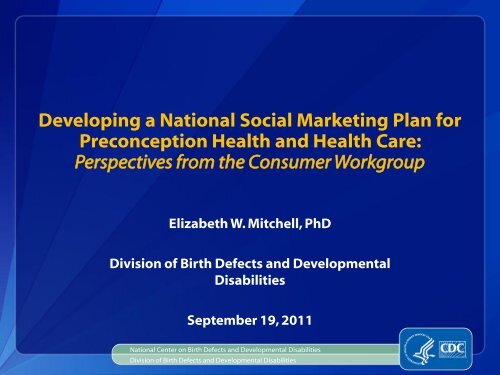Download the presentation - CityMatCH
Download the presentation - CityMatCH
Download the presentation - CityMatCH
You also want an ePaper? Increase the reach of your titles
YUMPU automatically turns print PDFs into web optimized ePapers that Google loves.
Developing a National Social Marketing Plan for<br />
Preconception Health and Health Care:<br />
Perspectives from <strong>the</strong> Consumer Workgroup<br />
Elizabeth W. Mitchell, PhD<br />
Division of Birth Defects and Developmental<br />
Disabilities<br />
September 19, 2011<br />
National Center on Birth Defects and Developmental Disabilities<br />
Division of Birth Defects and Developmental Disabilities
Presentation Overview<br />
Social marketing- what is it?<br />
Phases of a social marketing plan<br />
Status of <strong>the</strong> consumer workgroup’s social marketing<br />
planning by phase<br />
Next steps<br />
Discussion
WHAT IS SOCIAL MARKETING?
Social marketing is:<br />
"The application of commercial marketing technologies<br />
to <strong>the</strong> analysis, planning, execution, and evaluation of<br />
programs designed to influence voluntary behavior of<br />
target audiences in order to improve <strong>the</strong>ir personal<br />
welfare and that of society."<br />
* Andreasen, AR. Marketing Social Change: Changing Behavior to Promote Health, Social Development, and <strong>the</strong> Environment. San<br />
Francisco, CA: Jossey-Bass; 1995.
Problem<br />
Description<br />
Implementation<br />
Market<br />
Research<br />
Social<br />
Marketing<br />
Phases<br />
Evaluation<br />
Market<br />
Strategy<br />
Interventions<br />
Source: http://www.orau.gov/cdcynergy/demo/
1<br />
Social Marketing Phases<br />
Problem<br />
Description<br />
PUBLIC HEALTH, CONSUMER<br />
WORKGROUP AND SOCIAL<br />
MARKETING
Defining <strong>the</strong> Issue - Public Health Perspective<br />
Goal: To improve women’s health before<br />
pregnancy in order to optimize pregnancy<br />
outcomes<br />
• Pregnancy intention is associated with improved health<br />
behaviors and birth outcomes*<br />
Shah PS, Balkhair T, Ohlsson, A, Scott F, and Frick C. (2009). Systematic Review. Matern Child Health J. Published online: 10 December<br />
2009).
Key Challenges<br />
• Half of all pregnancies are not planned*<br />
• Target audience has a wide age range (18-44) and is<br />
diverse<br />
• The list of PCH behaviors is long<br />
• Messaging is challenging (language of PCH ; time<br />
period for promoting behaviors is unclear)<br />
• Health disparities<br />
Finer LB, Henshaw SK. Disparities in rates of unintended pregnancy in <strong>the</strong> United States, 1994 and 2001. Perspect Sex Reprod<br />
Health2006;38(2):90-6
Defining <strong>the</strong> Issue- A Call To Action<br />
Recommendations for preconception health and health<br />
care (2006)*<br />
Goals for preconception health initiative<br />
• Improve <strong>the</strong> knowledge, attitudes and behavior of men and<br />
women related to preconception health<br />
• To assure women of childbearing age receive preconception<br />
services that contribute to optimal birth outcomes<br />
• To reduce risks among women with a previous poor outcome<br />
• To reduce disparities by improving <strong>the</strong> health of all women before<br />
pregnancy<br />
*Johnson K, Posner SF, Biermann J, Cordero JF, Atrash HK, Parker CS, et al., Recommendations to improve preconception health and<br />
health care- United States. A report of <strong>the</strong> CDC/ATSDR Preconception Care Work Group and <strong>the</strong> Select Panel on Preconception Care.<br />
MMWR Recomm Rep. 2006;55(RR-6):1-23.
Defining <strong>the</strong> Issue- A Call To Action<br />
Work groups formed (i.e. policy, public health)<br />
• National consumer focused workgroup<br />
• Comprised of partner organizations<br />
Consumer workgroup focus<br />
• Increase public awareness of <strong>the</strong> importance of preconception<br />
health behaviors and preconception care services by using<br />
information and tools appropriate across various ages; literacy,<br />
including health literacy; and cultural and linguistic contexts<br />
• Encourage individual responsibility across <strong>the</strong> lifespan<br />
• Each woman, man and couple should be encouraged to have a<br />
reproductive life plan
Defining <strong>the</strong> Issue- Consumer Workgroup<br />
Perspective<br />
Responding to call to action<br />
• Strategic planning (2010-11)<br />
• Revisited overarching goals<br />
• Developing an actionable multi-organizational<br />
social marketing plan<br />
o Group attributes, gaps, needs<br />
o Sustainable<br />
o Monthly calls among partners to work on plan
Want To Learn More?<br />
Sign up sheet (workgroup information sheet)
Defining <strong>the</strong> Issue- Social Marketing Perspective<br />
The social marketing process involves<br />
• Identifying an effective marketing mix<br />
• 5 P‟s (product, price, promotion , place and partners)<br />
o<br />
o<br />
o<br />
o<br />
o<br />
What is <strong>the</strong> preconception health concept we are trying to sell to<br />
consumers? (product)<br />
What are <strong>the</strong> costs to consumers ? (price)<br />
How should demand for preconception health and healthcare<br />
(PCH & HC) to consumers be achieved? (promotion)<br />
Where should PCH & HC messages be promoted? (place)<br />
How can efforts be supported and sustained? (partners*)<br />
• Offering <strong>the</strong> customer clear and compelling benefits<br />
• Minimal barriers<br />
• And advantage over o<strong>the</strong>r options (competition)**<br />
*Luca, Nadina Ralulca and Suggs, L. Suzanne (2010) „Strategies for <strong>the</strong> Social Marketing Mix: A systematic Review‟, Social Marketing<br />
Quarterly, 16: 4, 122-149.<br />
** CE Prue, KL Daniel. Social marketing: planning before conceiving preconception care. Matern Child Health J2006;10(5 Suppl):S79-84.
Social Marketing Phases<br />
2<br />
Market<br />
Research<br />
RESEARCH TO INFORM SOCIAL<br />
MARKETING STRATEGY
Market Research Conducted or Underway<br />
Literature review (2009-2010)<br />
Materials evaluation (2009)<br />
Environmental scanning (2010)<br />
Partner assessments (2010 & 2011)<br />
Audience segmentation analyses (2009 & 2010)<br />
Focus groups (2010)<br />
Couple interviews (2010)<br />
Secondary data analysis- underway<br />
Concept development and testing (2011)<br />
Adcept development and testing- underway
Literature review<br />
Market Research (cont’d)<br />
• Syn<strong>the</strong>sized research on PCH & HC by audience<br />
(women, couples and clinicians) and by 4 P‟s to inform<br />
formative research plan<br />
Materials evaluation<br />
• Analysis of PCH materials to understand what is being<br />
communicated, to whom, and with what clinical<br />
emphasis<br />
• Overarching finding<br />
o Some materials used “preconception health” terminology,<br />
materials covered a wide range of clinical components,<br />
and most materials targeted a general audience of women
Market Research (cont’d)<br />
Environmental scanning<br />
• Web based assessments across range of areas<br />
• PCH branding, target audiences, existing materials, tools and<br />
campaigns, focus area (preconception, pregnancy, general<br />
health etc.)<br />
• Among a number of sectors: insurance, media (TV,<br />
magazine), foundations, public health, advocacy, web,<br />
business<br />
• Provided insight into <strong>the</strong> landscape of PCH,<br />
partnership and dissemination opportunities
Market Research- Partner Assessments<br />
Two partner assessments conducted (partner “P”)<br />
August 2010 and February 2011<br />
• Conducted in order to assess <strong>the</strong> attributes of <strong>the</strong> consumer<br />
workgroup in order to inform strategic planning, “center” social<br />
marketing planning efforts, assess gaps and opportunities<br />
• Focused on:<br />
• Each organization‟s goals<br />
• Their audiences<br />
• Activities (research, evaluation, education, communication)<br />
• Opportunities/barriers<br />
• Partnerships<br />
• Desired role in a national social marketing plan<br />
• Created a partnership database
Market Research- Audience Segmentation Analyses<br />
Purpose<br />
• Explore how women of childbearing age can be<br />
disaggregated into smaller groups so that effective and<br />
appropriate PCH social marketing interventions can be<br />
crafted
Market Research- Audience<br />
Segmentation Process<br />
Entire Population<br />
Target Population Groups<br />
i.e. Women of Childbearing<br />
Age<br />
Determined by<br />
Epidemiology or<br />
stratification data<br />
Kirby Marketing Solutions
Market Research- Audience<br />
Segmentation Process<br />
Entire Population<br />
Target Population Groups<br />
i.e. Women of Childbearing<br />
Age<br />
Determined by<br />
Epidemiology or<br />
Stratification Data<br />
Determined by<br />
Behavioral, Theoretical,<br />
or Multivariate Data<br />
Audience<br />
Segments<br />
Kirby Marketing Solutions
Market Research- Audience<br />
Segmentation Process<br />
Entire Population<br />
Target Population Groups<br />
i.e. Women of Childbearing<br />
Age<br />
Determined by<br />
Epidemiology or<br />
Stratification Data<br />
Determined by<br />
Behavioral, Theoretical,<br />
or Multivariate Data<br />
Audience<br />
Segments<br />
Intended<br />
Audience<br />
Determined by<br />
Selection Criteria<br />
Kirby Marketing Solutions
Market Research- Audience Segmentation Analyses<br />
Data<br />
• Porter Novelli‟s HealthStyles survey (2007 & 2009)<br />
Methods<br />
• Classification and regression tree (C&RT) and Chi- square<br />
automatic interaction detection (CHAID) to define factors most<br />
associated with level of pregnancy planning<br />
Results<br />
• Factors most associated with pregnancy planning**<br />
• timing,* contraception, marital status*, income<br />
• Insight into segmentation strategies<br />
*Mitchell, E. W., Lewis, MA., Bann, C. et al. Formative Research on Preconception Health for Consumers. Poster <strong>presentation</strong> at <strong>the</strong><br />
National Conference on Health Marketing Communication, Marketing and Media, August 11-13 th , 2009, Atlanta GA<br />
**Mitchell, EW. , Miracle-McMahill, H, Levis, D. Opportunities for Preconception Health Social Marketing among Women- A U.S.<br />
Consumer Perspective. Presented at <strong>the</strong> First European Congress on Preconception Health, October 2010, Brussels, Belgium
Market Research- Focus Groups<br />
Purpose<br />
• To learn more about women’s knowledge, attitudes, and beliefs about<br />
preconception health behaviors and services (4 P’s)<br />
• What do women know, think and believe about PCH and HC?<br />
• What does PCH as a term mean?<br />
• What are <strong>the</strong> motivators and barriers ?<br />
• How do we communicate with women about PCH and HC?<br />
10 focus groups (N= 65) in Atlanta<br />
• Segmented by planning status (planner, non-planner, interconception)<br />
• By low and middle SES
Market Research- Focus Groups<br />
Overarching findings<br />
• General understanding of PCH behaviors and <strong>the</strong>ir importance<br />
• Less resonance as a “set of services” than as elements of one‟s lifestyle<br />
• Women who plan to have children in <strong>the</strong> near future and those<br />
who do not identify with PCH differently<br />
• What motivates <strong>the</strong>m (healthy baby vs. one‟s general health)<br />
o<br />
Term preconception implies planning desire<br />
• Motivators for planners: age, discussions with doctor, health of<br />
baby/mo<strong>the</strong>r, contribution to fertility, social support<br />
• Barriers include: addiction, lack of social support (unsupportive<br />
partner or family), expense, rationalization of birth outcomes,<br />
relevance<br />
• Need to position PCH among planners and non-planners in a way<br />
that will resonate with <strong>the</strong>m<br />
• Implications for terminology, messaging, dissemination
Purpose<br />
Market Research- Couple Interviews<br />
• To understand how couples consider, discuss, and support each o<strong>the</strong>r in<br />
<strong>the</strong> context of preconception health and related behaviors (4 P’s)<br />
• What do couples know, think and believe about PCH and HC?<br />
• What does PCH as a term mean to <strong>the</strong>m?<br />
• What are <strong>the</strong> motivators and barriers for <strong>the</strong>m?<br />
• How do we communicate with couples about PCH and HC?<br />
Telephone interviews (N = 58 couples), ~5,000 screened<br />
• Women 18-44 who were married or in committed relationship with a<br />
partner who was willing to participate in <strong>the</strong> interview<br />
• Segmented by planning status (planner, non-planner, interconception)<br />
• By low and middle SES
Market Research- Couple Interviews<br />
Overarching findings<br />
• General understanding of PCH behaviors and <strong>the</strong>ir importance<br />
• Acknowledgement of lack of relevance among non-planners, much<br />
easier task among planners<br />
o<br />
Not familiar with term PCH or related terms (reproductive life plan)<br />
• The relationship element is powerful<br />
• Can be a motivator (i.e. doing things toge<strong>the</strong>r, support, healthy family,<br />
partnership) and a barrier (i.e. financial stability, lack of support, fear of<br />
stigma from partner) for PCH and HC<br />
• Motivators: desire for a healthy baby, pregnancy planning<br />
• Barriers: poor relationship quality, poor communication,<br />
embarrassment, not planning on a pregnancy<br />
• Need to develop a strategy for PCH for couples who are planners<br />
and non-planners in a way that will resonate with <strong>the</strong>m<br />
• Stimulate communication among dyad (don‟t rely on provider to<br />
initiate conversations)<br />
• Implications for terminology, messaging, dissemination
Market Research- Secondary Data Analysis<br />
Additional data sources triangulated<br />
• PRAMS (2004-2008)<br />
• Growth from Knowledge/Mediamark Research and Intelligence<br />
(2009-2010)<br />
Accumulation of data streams used to inform<br />
• Segmentation recommendations<br />
• Social marketing plan<br />
• Dissemination opportunities
GFK-MRI DATA
GFK/MRI Survey Of The American Consumer<br />
Methodology<br />
• National probability sample<br />
• In-home interview and mail questionnaire<br />
• Adults age 18+<br />
• N = 26,000/year<br />
• Two-year data set (N = 52,545)<br />
• Oversampling and breakouts for top designated market areas<br />
(DMAs)
What Is GFK/MRI?<br />
Secondary market research data set that CDC has<br />
acquired<br />
550+ categories with close to 6,000 items<br />
• Brands<br />
• Media (internet, social media, magazines, TV, movies, radio,<br />
newspapers),<br />
• Products (food, tobacco use, alcohol use)<br />
• Lifestyle activities<br />
• Online activity, use of technology, entertainment, shopping,<br />
memberships, social interaction, travel<br />
• Health and medicine<br />
• Medical conditions, medication use, visits to doctors<br />
• Attitudes and opinion items (19 categories)<br />
• Diet, physical fitness, health, medicine, technology, media<br />
• Extensive demographics
Analytic Population (N = 10,461)<br />
Women ages 18-44 who are not currently pregnant<br />
Planners<br />
• Intend to become a parent in <strong>the</strong> next 12 months (n= 1,429)<br />
• Very likely or somewhat likely<br />
Non-Planners<br />
• Do not intend to become a parent in <strong>the</strong> next 12 months (n= 9,032)<br />
• Not very likely or not likely at all
Internet Activities (Last 30 Days)<br />
Planners (%) Non-Planners (%)<br />
18-24 25-34 35-44 18-24 25-34 35-44<br />
Email<br />
Made a purchase for personal use<br />
Obtained <strong>the</strong> latest news/<br />
current events<br />
Paid bills online<br />
Played games online<br />
Look for employment<br />
Looked for recipes<br />
<strong>Download</strong>ed music<br />
Shared photos through internet<br />
website
Internet Activities (Last 30 Days)<br />
Planners (%) Non-Planners (%)<br />
18-24 25-34 35-44 18-24 25-34 35-44<br />
Email 79<br />
Made a purchase for personal use 30<br />
Obtained <strong>the</strong> latest news/<br />
current events<br />
36<br />
Paid bills online 40<br />
Played games online 40<br />
Look for employment 37<br />
Looked for recipes 22<br />
<strong>Download</strong>ed music 44<br />
Shared photos through internet<br />
website<br />
36
Internet Activities (Last 30 Days)<br />
Planners (%) Non-Planners (%)<br />
18-24 25-34 35-44 18-24 25-34 35-44<br />
Email 79 76<br />
Made a purchase for personal use 30 49<br />
Obtained <strong>the</strong> latest news/<br />
current events<br />
36 52<br />
Paid bills online 40 56<br />
Played games online 40 27<br />
Look for employment 37 27<br />
Looked for recipes 22 45<br />
<strong>Download</strong>ed music 44 33<br />
Shared photos through internet<br />
website<br />
36 42
Internet Activities (Last 30 Days)<br />
Planners (%) Non-Planners (%)<br />
18-24 25-34 35-44 18-24 25-34 35-44<br />
Email 79 76 74<br />
Made a purchase for personal use 30 49 44<br />
Obtained <strong>the</strong> latest news/<br />
current events<br />
36 52 53<br />
Paid bills online 40 56 50<br />
Played games online 40 27 22<br />
Look for employment 37 27 23<br />
Looked for recipes 22 45 36<br />
<strong>Download</strong>ed music 44 33 22<br />
Shared photos through internet<br />
website<br />
36 42 32
Internet Activities (Last 30 Days)<br />
Planners (%) Non-Planners (%)<br />
18-24 25-34 35-44 18-24 25-34 35-44<br />
Email 79 76 74 83<br />
Made a purchase for personal use 30 49 44 36<br />
Obtained <strong>the</strong> latest news/<br />
current events<br />
36 52 53 46<br />
Paid bills online 40 56 50 37<br />
Played games online 40 27 22 39<br />
Look for employment 37 27 23 30<br />
Looked for recipes 22 45 36 33<br />
<strong>Download</strong>ed music 44 33 22 49<br />
Shared photos through internet<br />
website<br />
36 42 32 45
Internet Activities (Last 30 Days)<br />
Planners (%) Non-Planners (%)<br />
18-24 25-34 35-44 18-24 25-34 35-44<br />
Email 79 76 74 83 81<br />
Made a purchase for personal use 30 49 44 36 47<br />
Obtained <strong>the</strong> latest news/<br />
current events<br />
36 52 53 46 52<br />
Paid bills online 40 56 50 37 55<br />
Played games online 40 27 22 39 29<br />
Look for employment 37 27 23 30 24<br />
Looked for recipes 22 45 36 33 41<br />
<strong>Download</strong>ed music 44 33 22 49 33<br />
Shared photos through internet<br />
website<br />
36 42 32 45 41
Internet Activities (Last 30 Days)<br />
Planners (%) Non-Planners (%)<br />
18-24 25-34 35-44 18-24 25-34 35-44<br />
Email 79 76 74 83 81 80<br />
Made a purchase for personal use 30 49 44 36 47 45<br />
Obtained <strong>the</strong> latest news/<br />
current events<br />
36 52 53 46 52 51<br />
Paid bills online 40 56 50 37 55 50<br />
Played games online 40 27 22 39 29 24<br />
Look for employment 37 27 23 30 24 18<br />
Looked for recipes 22 45 36 33 41 42<br />
<strong>Download</strong>ed music 44 33 22 49 33 22<br />
Shared photos through internet<br />
website<br />
36 42 32 45 41 32
Internet Activities (Last 30 Days)<br />
Planners (%) Non-Planners (%)<br />
18-24 25-34 35-44 18-24 25-34 35-44<br />
Email 79 76 74 83 81 80<br />
Made a purchase for personal use 30 49 44 36 47 45<br />
Obtained <strong>the</strong> latest news/<br />
current events<br />
36 52 53 46 52 51<br />
Paid bills online 40 56 50 37 55 50<br />
Played games online 40 27 22 39 29 24<br />
Look for employment 37 27 23 30 24 18<br />
Looked for recipes 22 45 36 33 41 42<br />
<strong>Download</strong>ed music 44 33 22 49 33 22<br />
Shared photos through internet<br />
website<br />
36 42 32 45 41 32
Cable, Satellite or Fiber Optic Programming<br />
Watched (Last 30 Days)<br />
Planners (%) Non-Planners (%)<br />
18-24 25-34 35-44 18-24 25-34 35-44<br />
ABC Family Channel 46 33 32 40 33 33<br />
CNN 17 27 33 20 23 28<br />
Comedy Central 36 24 22 34 24 19<br />
The Discovery Channel 30 32 34 27 27 31<br />
The Discovery Health Channel 14 16 16 16 14 14<br />
The Disney Channel 37 32 26 35 33 28<br />
Food Network 31 31 36 32 34 33<br />
Fox News Channel 18 23 33 18 21 30<br />
Lifetime 42 32 33 34 31 35<br />
MTV 48 30 17 47 30 16<br />
TBS 40 34 30 39 35 29<br />
TeenNick 8 3 2 9 3 2<br />
TLC 27 34 26 32 29 28<br />
VH1 40 24 16 41 26 15<br />
VH1 Classic 4 5 4 5 4 3<br />
The Wea<strong>the</strong>r Channel 22 27 29 20 28 33
Cable, Satellite or Fiber Optic Programming<br />
Watched (Last 30 Days)<br />
Planners (%) Non-Planners (%)<br />
18-24 25-34 35-44 18-24 25-34 35-44<br />
ABC Family Channel 46 33 32 40 33 33<br />
CNN 17 27 33 20 24 28<br />
Comedy Central 36 24 22 34 24 19<br />
The Discovery Channel 30 32 34 27 27 31<br />
The Discovery Health Channel 14 16 16 16 14 14<br />
The Disney Channel 37 32 26 35 33 28<br />
Food Network 31 31 36 32 34 33<br />
Fox News Channel 18 23 33 18 21 30<br />
Lifetime 42 32 33 34 31 35<br />
MTV 48 31 17 47 30 16<br />
TBS 40 34 30 39 35 29<br />
TeenNick 8 3 2 9 3 2<br />
TLC 27 34 26 32 29 28<br />
VH1 40 24 16 41 26 15<br />
VH1 Classic 4 5 4 5 4 3<br />
The Wea<strong>the</strong>r Channel 22 27 29 20 28 33
Cable, Satellite or Fiber Optic Programming<br />
Watched (Last 30 Days)<br />
Planners (%) Non-Planners (%)<br />
18-24 25-34 35-44 18-24 25-34 35-44<br />
ABC Family Channel 46 33 32 40 33 33<br />
CNN 17 27 33 20 24 28<br />
Comedy Central 36 24 22 34 24 19<br />
The Discovery Channel 30 32 34 27 27 31<br />
The Discovery Health Channel 14 16 16 16 14 14<br />
The Disney Channel 37 32 26 35 33 28<br />
Food Network 31 31 36 32 34 33<br />
Fox News Channel 18 23 33 18 21 30<br />
Lifetime 42 32 33 34 31 35<br />
MTV 48 30 17 47 29.85 16<br />
TBS 40 34 30 39 35 29<br />
TeenNick 8 3 2 9 3 2<br />
TLC 27 34 26 32 29 28<br />
VH1 40 24 16 41 26 15<br />
VH1 Classic 4 5 4 5 4 3<br />
The Wea<strong>the</strong>r Channel 22 27 29 20 28 33
AUDIENCE SEGMENTS FOR SOCIAL<br />
MARKETING PLAN
Women of Childbearing Age- Planners and Non-<br />
Planners<br />
Pregnancy Planners<br />
• Women who intend to have a child in <strong>the</strong> next 1-2 years<br />
Non-Pregnancy Planners<br />
• Women who do not intend to have a child in <strong>the</strong> next 1-2 years<br />
Segmentation based on<br />
• Desire to make concepts and messages relevant<br />
• Increase attention and engagement in messages<br />
• Desire to reach <strong>the</strong> audience<br />
• What channels and why?
Planners are Contemplators<br />
More likely to pay attention to and be receptive to<br />
messages about PCH<br />
• In <strong>the</strong> “pregnancy mindset”<br />
• May be starting to mentally prepare to get pregnant or are actively<br />
trying to get pregnant<br />
Motivated by messages that focus on<br />
• Health of <strong>the</strong> baby<br />
• Health of mo<strong>the</strong>r during pregnancy and delivery<br />
• Prospect of enhancing fertility<br />
Desire to be pregnant is a strong motivator to engage<br />
in PCH behaviors
Non-Planners are Pre-Contemplators<br />
Lower levels of awareness of PCH<br />
Less likely to be receptive to messages about PCH<br />
• Pregnancy is not on <strong>the</strong>ir radar<br />
Less likely to engage in and be motivated to engage in<br />
PCH behaviors (e.g., folic acid)<br />
• Viewed as irrelevant to <strong>the</strong>ir current life<br />
• More likely to engage in unhealthy lifestyle behaviors (e.g., smoke)<br />
and question need to stop<br />
More likely to be receptive to messages about overall<br />
healthy behaviors/lifestyle<br />
• There is not a trigger event for non-planners to motivate behavior<br />
change
Stages of Change<br />
Precontemplation<br />
PLANNERS<br />
Contemplation<br />
NON-<br />
PLANNERS<br />
Preparation<br />
Action<br />
Prochaska, J. O., & DiClemente, C. C. (1983). Stages and processes of self-change of smoking: Toward an integrative model of change.<br />
Journal of Consulting and Clinical Psychology, 51, 390-395.
Planners<br />
Short Term Communication Goals<br />
• Increase awareness of PCH behaviors<br />
• Increase awareness that <strong>the</strong>re is a preconception time period<br />
• Increase awareness that what <strong>the</strong>y do before <strong>the</strong>y get pregnant<br />
can affect <strong>the</strong> health of <strong>the</strong>ir baby<br />
• Increase awareness about where to obtain information about PCH<br />
Non-Planners<br />
• Increase awareness about being healthy (PCH)<br />
• Increase awareness about contraception (RLP)<br />
• Increase awareness about where to obtain information about<br />
women‟s health (PCH)
CREATIVE DEVELOPMENT AND<br />
TESTING
Market Research- Concept Development and Testing<br />
Purpose (product “P”)<br />
• Position PCH & HC (empowering, engaging, memorable)<br />
• Create an overarching umbrella brand that can be used by <strong>the</strong><br />
CDC and partners<br />
• Link PCH to consumer values<br />
• A relationship between a product, service, or behavior and its<br />
consumers<br />
• Creates a set of expectations in <strong>the</strong> mind of consumers (brand<br />
promise)<br />
• Create a vehicle for promoting PCH & HC<br />
• One communication channel will reinforce ano<strong>the</strong>r and increase<br />
credibility (among partners, health care providers, media, web etc.)
Market Research- Concept Development and Testing<br />
Positioned PCH and HC<br />
• A unique time (WOMAN‟S WINDOW)<br />
• An opportunity (CREATE YOUR FUTURE)<br />
• An invitation (Baby YOURSELF, BABY yourself )
Market Research- Concept Development and Testing<br />
Concept testing completed in May<br />
• 4 focus groups (N = 32) in Atlanta<br />
Purpose<br />
• Segmented by planning status (planners vs. non-planners)<br />
• Two age groups: 18-30 and 31-44<br />
• All low to middle income<br />
• Gauge women‟s understanding, impressions and attitudes toward<br />
concepts<br />
• Clarity, appeal, motivation (text, images and <strong>the</strong>n PCH context)
Market Research- Concepts, Adcepts and Testing<br />
Findings<br />
• Important feedback<br />
• Creative executions (headline, tagline, images, text box)<br />
• Revised “Woman‟s Window” and “Baby Yourself”<br />
• Developed “Show Your Love” concept<br />
• Developed logos<br />
• “Create Your Future”- dropped<br />
• Instead of inspiring respondents it evoked stress (school, career,<br />
financial)<br />
Kaiser Women’s Health Survey (2008):<br />
“Approximately a quarter of women report feeling high levels of stress<br />
from career (23%), and financial concerns (26%)”.
Market Research- Concepts, Adcepts and Testing<br />
New and revised adcepts<br />
Positioning PCH and HC<br />
• Nurturing (Show your love)<br />
• A unique time (Woman‟s Window)<br />
• Self empowering (Baby Steps)
Market Research- Concepts, Adcepts and Testing<br />
Next steps<br />
• Test adcepts via on-line survey<br />
• A sample of women 18-44 years from Knowledge Networks panel<br />
• Groups:<br />
o<br />
o<br />
• Early Winter 2011<br />
Non-planners (never intend or intend to have a baby in more<br />
than 2 years)<br />
Planners (intend to have a baby
Social Marketing Phases<br />
3<br />
Market<br />
Strategy<br />
MARKETING MIX AND ACTION PLAN
5 Ps Data Sources<br />
Product<br />
Literature review<br />
Materials evaluation<br />
CWG input<br />
PRODUCT<br />
Environmental scanning<br />
Formative research<br />
Concept/adcept testing<br />
CWG input<br />
Price<br />
Literature review<br />
Materials evaluation<br />
Environmental scanning<br />
Partner assessments<br />
Promotion<br />
Place<br />
Environmental scanning<br />
Audience segmentation analyses<br />
Focus groups<br />
Literature review<br />
Materials evaluation<br />
CWG input<br />
Literature review<br />
Materials evaluation<br />
CWG input<br />
Couple interviews<br />
Secondary data CWG input analysis<br />
Partners<br />
Literature review<br />
Environmental scanning<br />
Partner assessment<br />
Concept/Adcept testing<br />
Materials evaluation<br />
Environmental scanning<br />
Partner assessment<br />
Environmental scanning<br />
Formative research<br />
Secondary data analysis<br />
Concept/adcept testing<br />
Partner assessment<br />
Audience segmentation analyses<br />
Formative research<br />
Secondary data analysis<br />
Audience segmentation analyses<br />
Formative research<br />
Secondary data analysis<br />
CWG input<br />
Formative research<br />
Secondary data analysis
Problem<br />
Description<br />
Market<br />
Research<br />
Social<br />
Marketing<br />
Phases<br />
Source: http://www.orau.gov/cdcynergy/demo/
Problem<br />
Description<br />
Implementation<br />
Market<br />
Research<br />
Social<br />
Marketing<br />
Phases<br />
Evaluation<br />
Market<br />
Strategy<br />
Interventions<br />
Source: http://www.orau.gov/cdcynergy/demo/
NEXT STEPS
Next Steps<br />
Finalize<br />
• Marketing strategy, intervention, implementation and evaluation<br />
plan (early 2012)<br />
Complete and disseminate PCH & HC social marketing<br />
tools<br />
• Audience profiles<br />
• Brand support products (sample materials, logos etc.)<br />
• PCH video<br />
• Manuscripts and reports<br />
Recruit additional partners
WHAT’S MISSING?
Project team<br />
Consumer Workgroup<br />
Thank You Project Team<br />
CDC : Heidi Miracle-McMahill, MPH, MS; Denise Levis, MA,<br />
PhD, Mindy Barringer<br />
RTI : Linda Squiers, PhD; Megan Lewis, PhD; Molly Lynch,<br />
MPH; Karen Isenberg, MPH; Julia Kish-Doto, PhD;<br />
Rebecca Munch<br />
AIR : Lori Agin, Mark Cohen, Lynda Bardfield, Jon Stapp,<br />
Tom Hrabal, Martha Mater, Margarita Hurtado, PhD,<br />
Tamika Owens, Allison Fratto
Questions?<br />
On-line social marketing planning tool:<br />
• http://www.orau.gov/cdcynergy/demo/<br />
Before, beyond and between pregnancy (slides)<br />
• http://www.beforeandbeyond.org/
Thank you<br />
For more information please contact Centers for Disease Control and Prevention<br />
1600 Clifton Road NE, Atlanta, GA 30333<br />
Telephone, 1-800-CDC-INFO (232-4636)/TTY: 1-888-232-6348<br />
E-mail: cdcinfo@cdc.gov<br />
Web: www.cdc.gov<br />
The findings and conclusions in this report are those of <strong>the</strong> authors and do not necessarily represent <strong>the</strong> official<br />
position of <strong>the</strong> Centers for Disease Control and Prevention.<br />
National Center on Birth Defects and Developmental Disabilities<br />
Division of Birth Defects and Developmental Disabilities







